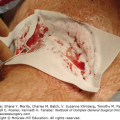Biliary Tract Cancer
Sunyoung S. Lee
Milind Javle
Molecular Targeted Therapy
The molecular analyses of molecular profiling show that up to 35% of patients with cholangiocarcinoma have potentially targetable genomic alterations (1).
Gene mutations commonly found in cholangiocarcinoma are categorized into five subgroups: receptor tyrosine kinases (FGFR), cell cycle-related genes (TP53, CDKN2A mutation/deletion, and CCND1 amplification), IDH1/2 alterations, MAPK pathway (KRAS, NRAS, and BRAF), and chromatin modifying (ARID1A/B, BAP1, and PBRM1) (2,3,4).
Patients with FGFR2 alterations show better prognosis, and those with KRAS and TP53 mutations have worse prognosis. IDH1/2 alterations are neutral in prognosis. BAP1 is related to a more aggressive subtype and associated with poor prognosis.
IDH1 MUTATION
Isocitrate dehydrogenase (IDH) mutations (IDH1 and 2) are found in 20% to 25% of patients with intrahepatic cholangiocarcinoma.
An IDH1 inhibitor, ivosidenib (ClarIDHy trial) showed a modest survival benefit (5). Patients who progressed on placebo crossed over to ivosidenib: ORR, 2%; DCR, 53%; mPFS, 2.7 months. In an earlier analysis, 32% and 22% of patients on ivosidenib did not progress at 6 and 12 months (6).
Ivosidenib was recently approved by the FDA in the second-line setting.
FGFR2 GENE ALTERATIONS
Fibroblast growth factor receptor 2 (FGFR2) alterations are commonly found in 14% to 20% of patients with intrahepatic cholangiocarcinoma (7,8).
Pemigatinib, an FDA-approved inhibitor of FGFR1, 2, and 3, showed ORR, DCR, and median duration of response (mDOR) of 35.5%, 80.0%, and 7.5 months in FGFR2 fusions/rearrangements. Patients with other FGFR alterations or no FGF/FGFR alterations showed stable disease in 40% and 22% patients with no overall response.
Infigratinib, another FDA-approved inhibitor of FGFR1, 2, and 3, showed ORR of 23.1% (35% in the second-line setting and 13.8% in the third- and later-line settings) in FGFR2 fusions or rearrangements; mPFS, 7.3 months (9).
Futibatinib, an inhibitor of FGFR1, 2, 3, and 4 (10,11), showed mDOR of 6.2 months, ORR of 34.3%, and DCR of 76.1%.
Common adverse events from FGFR inhibitors include hyperphosphatemia, arthralgias, and ophthalmologic side effects including serous retinal detachment and dry eyes.
ERBB2 (HER2) AMPLIFICATION
HER2 (ERBB2) amplification is found in intrahepatic (3%), hilar and distal cholangiocarcinoma (11%), and gallbladder carcinoma (16%) (12). The role or sequence of HER2 blockade has not been established.
A phase II trial of trastuzumab and pertuzumab with 39 patients with HER2 amplification, HER2 overexpression, or both showed ORR and DCR of 23% and 51%, respectively; mDOR, 10.8 months; mPFS and mOS of 4.0 and 10.9 months, respectively (13).
Stay updated, free articles. Join our Telegram channel

Full access? Get Clinical Tree




